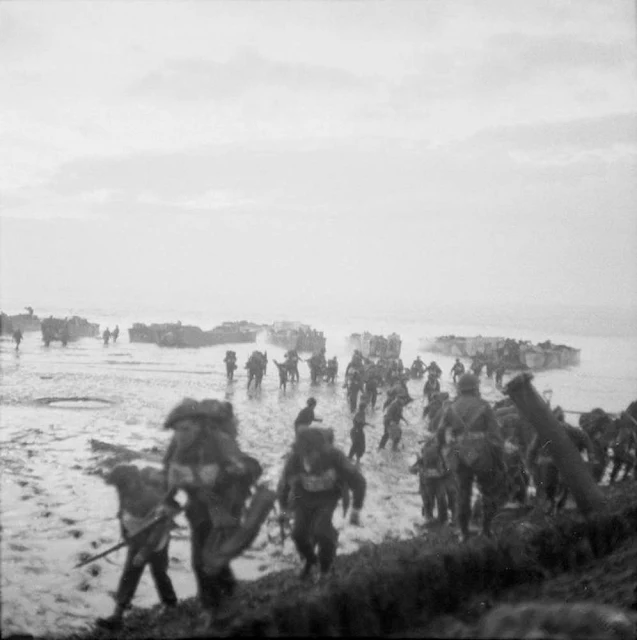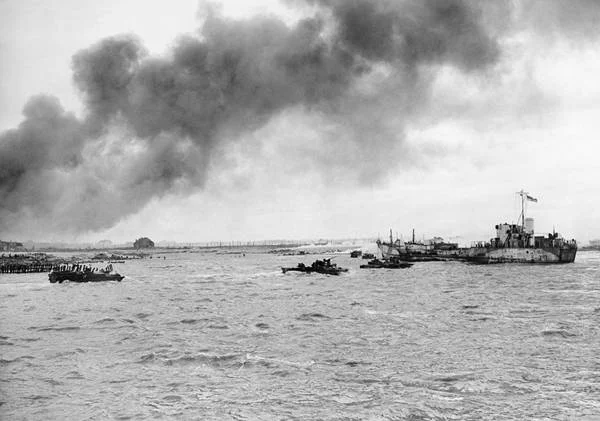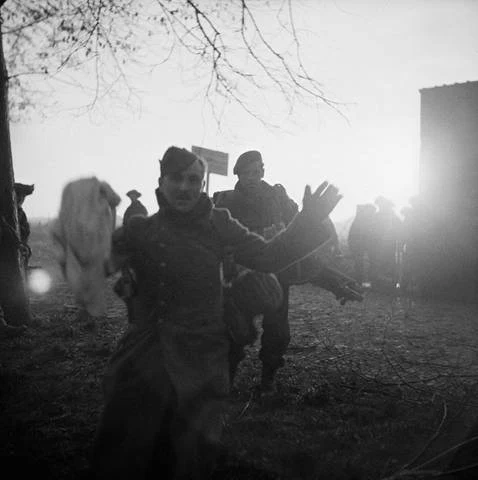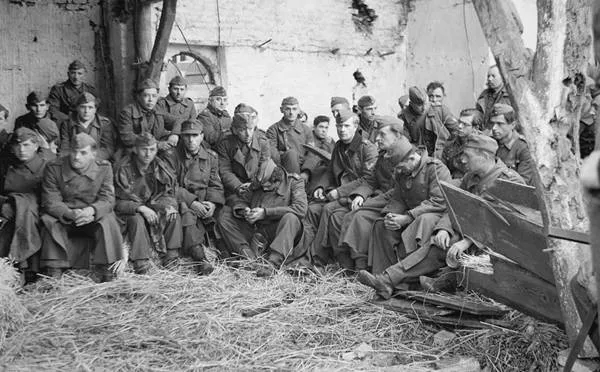by C. P. Stacey
The Scheldt Estuary operations made a vital contribution to Allied victory in the Second World War. They provided logistical facilities essential to the final assault on Germany. By the early autumn of 1944 the Allied Expeditionary Force in northwest Europe was in serious administrative difficulties. Following its victory in Normandy and rapid pursuit of the enemy across France and Belgium, its lines of communication were stretched to the breaking point. It was still dependent on supplies landed in the original bridgehead in Normandy, and the long haul from the beaches there almost to the German frontier placed such a strain on transport resources that not enough fuel was reaching the front to keep all the Allied armies moving.
The problem could only be solved by acquiring large port facilities closer to the front. Antwerp, the greatest port in northwest Europe, capable of bringing in 30,000 tons a day, was captured undamaged by the British 11th Armored Division on 4 September; but the Germans still held both banks of the River Scheldt between Antwerp and the sea, and the port could not be used until they were dislodged. They fully realized how important their positions were to the security of the Fatherland, and the First Canadian Army’s task in evicting them turned out to be very hard.
The clearing of the Estuary was carried out by the 2nd Canadian Corps, employing four divisions (one of which was armored) and a commando brigade. The Royal Navy and Royal Air Force both played vital parts. Five water-borne assault landings were made. For the first time in history large-scale inundations produced by aerial bombing were used to harass an enemy’s troops in battle.
Background of the Battle
Although the administrative significance of Antwerp was fully recognized, operations to open the port were postponed while Field Marshal Montgomery’s 21st Army Group made a bold attempt to thrust across the lower Rhine before the Germans could recover themselves after the Normandy defeat (unfortunately, the Germans were becoming quite well recovered from this defeat and sketchy spy and partisan reports stated this, but Allied intelligence did not believe it). But the great combined airborne-ground operation called Market-Garden failed of its main objective, and on the night of 25-26 September, the remnants of the British 1st Airborne Division were withdrawn across the Neder River from their precarious foothold near Arnhem. Thereafter the opening of Antwerp was given first priority. While Arnhem fighting was in progress, General Eisenhower and Field Marshal Montgomery had been arguing over strategy, the latter emphasizing strongly what he considered the importance of concentrating the available administrative resources on his own front in the north for a blow at the great Ruhr industrial area. Montgomery believed seriously that he could end the war before the end of 1944, but without the port of Antwerp this was an impossibility. To use Antwerp, the Scheldt had to be cleared and Montgomery wasted precious time arguing with Eisenhower. On 22 September Eisenhower sent Montgomery a letter which concluded:
No one is more anxious than I to get to the Ruhr quickly. It is for the campaign from there onward deep into the heart of Germany for which I insist all other troops must be in position to support the main drive. The main drive most logically go by the North. It is because I am anxious to organize that final drive quickly upon the capture of the Ruhr that I insist upon the importance of Antwerp. As I have told you I am prepared to give you everything for the capture of the approaches to Antwerp, including all the air forces and anything else you can support.
During September, Lieutenant-General Henry D. G. Crerar’s First Canadian Army was occupied with clearing the Channel ports. By 1 October it had captured Le Harve, Dieppe, Boulogne, Calais and Ostend. All these ports were so badly damaged that it took weeks to get them to work, and then their capacity was limited. The importance of Antwerp was more and more evident.
The task of opening the Scheldt was formally assigned to the First Canadian Army on 14 September. On the 15th, General Crerar allotted the operation to the 2nd Canadian Corps, commanded by Lieutenant-General G. G. Simonds. The task before the Corps commander was formidable. The West Scheldt, a winding channel, extends some 50 miles from Antwerp to the sea. It was heavily mined throughout its length. Along the south side the enemy still held a large bridgehead, protected on the most of its land front by the Leopold Canal. On the north stood the fortified island of Walcheren, joined by a causeway to the long peninsula of South Beveland, above which the right bank of the Scheldt was also in enemy hands almost to Antwerp. Most of the land about the estuary was reclaimed ground, low-lying tilled fields, cut by ditches and dikes and easily flooded. Nearly all of Walcheren and much of South Beveland lay so low that, if the seaward dikes were broken, inundation would result.
General Simonds’ appreciation of 21 September envisaged airborne and waterborne attacks upon Walcheren following heavy air bombardment. He recommended that Walcheren be flooded by bomber attacks upon the sea dikes. He proposed that the 2nd Canadian Infantry Division should push northward from Antwerp to cut off South Beveland and exploit the land approach to Walcheren via South Beveland as far as possible. The clearing of the bridgehead south of the Scheldt he assigned to the 3rd Canadian Infantry Division.
The Army commander agreed that the Walcheren dikes should be breached, provided that this was technically feasible and the higher authorities concurred. Army engineers expressed the view that breaching the dikes was impracticable, and an officer from the RAF Bomber Command who attended a conference at Army Headquarters on 23 September was not prepared to commit himself on the question. General Simonds, after considering the matter again, was still of the opinion that the attempt should be made; and Army Headquarters recommended the plan to the 21st Army Group, which supported it. The RAF, while not guaranteeing success, was willing to try. At this point illness forced General Crerar to hand over the Army temporarily to General Simonds. Major-General Charles Foulkes took over the 2nd Canadian Corps.
Supreme Headquarters had refused an airborne operation against Walcheren, the terrain being considered unsuitable. But the Supreme Commander now authorized the flooding operation. On 3 October Bomber Command made the experiment at Westkapelle, and the dike was successfully breached. The previous day General Simonds had issued his directive. It required the 1st British Corps (now in the Antwerp area and attached to the First Canadian Army) to use the 2nd Canadian Division to close the eastern end of the South Beveland isthmus. The 2nd Canadian Corps would clear the area south of the Scheldt and subsequently capture South Beveland and Walcheren.
The 2nd Division Pushes North
The 2nd Canadian Infantry Division moved northward from the Antwerp area on 2 October, crossing the Dutch border on the 5th. On the 7th the division reverted to the control of the 2nd Canadian Corps. As the 1st British Corps had directed its main thrust northeastward from Antwerp, the division’s right flank was exposed. It now encountered fierce enemy opposition in the area of Woensdrecht, a village blocking the entrance to the isthmus of South Beveland, and the advance was checked. Very bitter fighting followed. On the 10th the 4th Canadian Infantry Brigade temporarily cut one isthmus; on the 16th an attack by the same brigade secured a tenuous hold on Woensdrecht; but the situation was still very insecure. The Germans had committed here on 12 October one of their “fire brigades,” “Battle Group Chill” (also known as the 85th Infantry Division), whose backbone was a regiment of hard-fighting paratroopers.
At the same time, the operation against the bridgehead south of the Scheldt was also meeting heavy opposition and moving slowly. There was now a change of policy on the part of the high command. So far, it would seem, both Eisenhower and Montgomery had hoped that the 21st Army Group could open the Scheldt without abandoning operations which the Second British Army was conducting against the enemy bridgehead remaining west of the Maas—i.e., east of the salient created by Market-Garden. It was now evident that this could not be done. On 13 October, Eisenhower sent a strong directive to Montgomery emphasizing the extreme importance of being able to use Antwerp soon, and offering assistance in troops and supplies for the purpose. Eisenhower wrote that if after receiving his views, Montgomery still regarded them as unsatisfactory, then an issue would exist that would have to be settled by higher authority. Only then, on 16 October, did Montgomery, reluctant still, force his attention away from the Ruhr and issue a new directive to his Army commanders, closing down all operations except those directed towards the Scheldt to provide a logistical base for operations to come. The Second Army was to take over the right portion of the Canadian Army’s line and push westward; the Canadian Army, with more troops available, was to clear the country north of the South Beveland isthmus.
These new orders soon transformed the situation. The 1st British Corps was now given the whole of the 4th Canadian Armored Division (of which some elements had already been operating on the right of the 2nd Division) and also the 104th U.S. Infantry Division; and it proceeded to push northward. On the 22nd the armored division captured Esschen and attacked toward Bergen-op-Zoom, which fell on the 27th. With the capture of Esschen, the right flank was secure. On the 23rd, the 2nd Division attacked north of Woensdrecht, making only limited advances, but next day operations went better; the vigorous action of the 4th Armored Division to the east had caused the enemy to retire. The way into South Beveland was open.
On 20 October, Montgomery sent a personal note to Simonds acknowledging a copy of his latest directive. He wrote:
I think everything you are doing is excellent. And your troops are doing wonders under the most appalling conditions of ground and weather. I doubt if any other troops would do it so well, and I am very glad the Canadians are on the business. Please tell all your chaps how pleased I am with their good work.
Operation Switchback: The Breskens Pocket
On 6 October the 3rd Canadian Division commenced Operation Switchback, attacking the German pocket south of the West Scheldt at the point where the Leopold Canal diverges from the Canal de Derivation de la Lys. The Leopold Canal was a formidable obstacle, about 60 feet wide and with steep banks. Inundations to the north of the canal left only a narrow strip of land where we could develop our bridgehead. The 7th Canadian Infantry Brigade made a sudden assault supported by Wasps—flame-throwing carriers. The attack was made through the 4th Canadian Armoured Division, which put in two diversionary attacks, one on either side of the bridgehead. After acquiring a shallow foothold the attack bogged down in the face of strong opposition. General von Zangen, commanding the German Fifteenth Army in the Netherlands, had allotted an efficient formation, the 64th Infantry Division, to the defense of what the Germans called “Scheldt Fortress South.” This formation now held the 7th Brigade’s bridgehead to narrow limits.
An amphibious assault was now made against the rear of the pocket. The 9th Brigade’s assault force embarked at Ghent in Buffalos (Landing Vehicles, Tracked) and sailed down the canal leading to Terneuzen. At 2:00 a.m. on 9 October they set off across the Braakman inlet,[1] supported by fire from artillery of the 4th Canadian Armoured Division. Both attacking battalions got ashore near Biervliet quickly and reorganized against slight opposition. By 9:00 a.m. a bridgehead 1,500 yards deep had been established and soon the reserve battalion was landed, advancing to Hoofdplaat.
The attack over the Braakman had met with so much success that it was now decided to reinforce there instead of on the Leopold Canal as previously planned. The 3rd Division’s reconnaissance regiment was sent over on the 11th, followed by the 8th Brigade. The enemy had now moved up forces to face this threat at his left rear; the going became tougher. On the 14th troops of the 4th Canadian Armoured Division succeeded in crossing the Leopold near Watervliet and near the head of the Braakman, making it possible to send supplies and artillery by road into Scheldt Fortress South. The 8th and 9th Brigades advanced slowly westward against opposition.
On the 16th resistance before the 7th Brigade suddenly slackened. At last light on the 18th the brigade was relieved by the 157th Brigade of the 52nd (Lowland) Division. The 157th pushed forward and on the 19th made contact with the force that had crossed the Braakman.
The 3rd Division now moved to cut the German forces off from the Scheldt. The 9th Brigade captured Breskens on the 22nd in the face of heavy enemy artillery fire, particularly from Flushing. The Germans’ communications with Walcheren were virtually severed. Next day the 9th Brigade swung southwestward and captured Schoondijke. After taking Fort Frederik Hendrik this formation was withdrawn into reserve and the 7th Brigade struck out westward, capturing Cadzand on the 29th. The 8th Brigade meanwhile had shifted southward, relieving the 157th. Sluis fell on 1 November. On the same day the German divisional commander was captured near Knocke-sur-Mer. The 8th Brigade cleared westward along the Leopold Canal and on 3 November opposition was at an end in Scheldt Fortress South. Operation Switchback was over.
Operation Vitality: South Beveland
Meanwhile, on 24 October the 4th Brigade had led the advance west down the isthmus of South Beveland, thus beginning Operation Vitality. The entire German force west of the isthmus consisted of the weak 70th Infantry Division,[2] less one grenadier regiment with some other troops and naval coast artillery units. To dislodge enemy rearguards from the line of the Beveland Canal, Simonds mounted another amphibious operation. Carried in some 120 tracked landing craft, the 156th Infantry Brigade of the 52nd Division crossed from Terneuzen on the night of 25-26 October, landing in South Beveland. A good bridgehead was immediately established. On the 26th the 6th Brigade attacked towards the Beveland Canal. One battalion reached the canal late on the 27th after wading waist-deep water, and seized a bridgehead on the far side. Another gained a crossing in the middle of the isthmus. By the 29th the 2nd Division had two brigades over the canal. The 157th Brigade, which had landed in the 156th Brigade’s bridgehead on the West Scheldt, moved on the southern flank. Goes fell on the 29th, and by the 30th the 5th Brigade had a battalion within two miles of the causeway leading to Walcheren.
The 4th Brigade now put in a night attack, clearing the eastern end of the causeway.
The Lowland Division came up on the left and by morning of 31 October the German hold on South Beveland was ended. The causeway, however, was strongly defended. On the afternoon of the 31st the 5th Brigade took over from the 4th and attempted to cross the 1,100 yard cratered, fire-swept roadway to Walcheren. The leading troops finally forced their way across and gained a precarious foothold, which was lost and then restored. The decision was now made to relieve the brigade with the 157th Brigade, and the 2nd Canadian Division was withdrawn for rest. Meanwhile, troops of the 2nd Division’s reconnaissance regiment captured the island of North Beveland on 2 November. The attack on Walcheren had already begun.
Operation Infatuate: Walcheren
Like a half-drawn cork in the very mouth of the Scheldt River, the island of Walcheren is roughly rectangular in shape, about ten miles long by eight miles broad. The village of Westkapelle lies at the westerly corner, the port of Flushing at the southerly one. The island is low-lying, most of it below mean sea level. Only the coastal strip of dunes on the northwest and southwest sides, and the eastern-most section of the island, are higher than the sea.
The island was heavily fortified. There were coast-defense guns up to 8.7-inch including a dozen 5.9-inch. The island was garrisoned by remnants of a German division and other elements of the German Fifteenth Army, the total being estimated at between 6,000 and 7,000 (to the surprise of the Allies, the number of prisoners taken exceeded the number of German troops estimated to be on Walcheren). In the period 3-17 October the heavy bombers of the RAF made four heavy attacks on the sea dikes of Walcheren, breaching them in four places and allowing the sea to pour in. These bombers did not wipe out the defensive positions but put most of the island waist-deep in water, making operations all the more difficult. The island was now like an immersed saucer with only the rim showing.
The first waterborne attack in Operation Infatuate, the assault on Walcheren, went in against Flushing before daylight on 1 November, when the 4th Commandos crossed the West Scheldt from Breskens following a bombing attack by the RAF. German gunfire destroyed nineteen out of twenty-five landing craft, killing and wounding 382 men. Three hundred guns, including those of two Canadian Army Groups Royal Artillery, hammered German defenses in the town from across the West Scheldt. The commandos were soon ashore and in possession of a bridgehead. The 155th Infantry Brigade now sent a battalion across to assist in clearing Flushing. Next morning the rest of the brigade crossed over and one battalion advanced toward Middelburg. On the 3rd the headquarters of the Flushing garrison was captured, after an advance through deep flood waters; and by nightfall the city was clear.
The climax of the Walcheren operation came at Westkapelle. Soon after first light on 1 November a seaborne attack was delivered at that point. The assault force, consisting of units of the 4th Commandos under command of the 2nd Canadian Corps, a naval bombarding force and a support squadron, approached the island from the west. When the support squadron, made up of twenty-seven landing craft armed with guns, rockets and smoke projectors, deployed five miles from shore it was immediately engaged by every German battery within range and began to suffer heavy losses. Four hours later nine craft had been lost and eleven were more or less badly damaged by gunfire. There were 372 casualties among the crews. Their gallantry and their sacrifices had purchased victory. British tactical investigators later came to the conclusion that the landing would have failed but for two facts: the German batteries fired at the craft that were firing at them, not at the personnel carriers; and one of the 5.9-inch batteries ran out of ammunition at a critical moment.
It had been planned that close air support would be given by fighter-bombers and rocket-firing Typhoons immediately before and after H-hour. Bad flying weather, however, prevented the fighter-bombers from taking off. It also interfered with air spotting for the naval bombardment ships, the aircraft being fog-bound in England. Fortunately, the Typhoons were able to come into action against the German defenses just as the first assault landing craft touched down on each side of the gap in the dike. One Commando landed, seized the town and nearby battery and advanced northeastwards. Another Commando, landing south of the gap, went on to the southeast along the dunes. During the next two days good progress was made in both directions.
The last landing on Walcheren was made on the eastern side south of the causeway, where the 156th Brigade sent a battalion across on the night of 2-3 November. Using assault boats and wading in the salt marshes, this unit established a secure bridgehead by nightfall. Next day another battalion followed and the troops at the west end of the causeway began to advance. On 6 November Middelburg fell to troops advancing from Flushing and the German general surrendered. By the 7th only the northern coast remained to be cleared. On the morning of the 8th German resistance on Walcheren came to an end. The fighting on Walcheren was done by British units, but medical service was provided by a unit of the Royal Canadian Army Medical Corps.
Both Naval and Army authorities blamed the heavy losses in the Westkapelle assault on the limited scale of bomber effort employed against the German batteries. It is true that many Allied air officers were reluctant to divert forces to these targets from the offensive against the German industrial complex; but a considerable number of attacks were actually made on Walcheren. It was particularly unfortunate that bad weather compelled the air force to cancel the attacks which had been planned for 31 October (D minus one).
The effect of the flooding—which, of course, meant much misery for the population of Walcheren—merits a word. While the German coastal batteries were on high ground and were not directly affected (though many of the anti-aircraft positions were put out of action), they were isolated by the waters, their communications were seriously interfered with and the German defense generally was greatly harassed. The attackers on the other hand were offered the advantage of being able to use amphibious vehicles throughout (not having to transport land vehicles for use on Walcheren) and thanks in part to these the operations went faster than those south of the Scheldt.
During the operations of the First Canadian Army from 1 October to 8 November, 41,043 German prisoners were taken, and the enemy suffered correspondingly heavy losses in killed and wounded. Commonwealth casualties exceeded 27,000 men (more than the total number of Allied casualties sustained in the invasion of Sicily in 1943).
With the clearing of Walcheren the Germans no longer commanded the sea approach to Antwerp. However, the West Scheldt was thickly sown with mines which the Navy had to clear (sixteen sweepings were required before the channel was finally usable). Not until 28 November did the first Allied convoy arrive in the port. But with cargo ships unloading at Antwerp a firm logistical foundation at last existed for the final drive into Germany.







































































